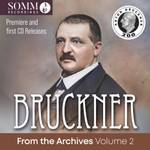|
Back
04/16/2024
“Bruckner: From the Archives, Volume 2”
Anton Bruckner: Mass n° 2 in E minor, WAB 27 [1] – Symphony in D minor “Die Nullte” (1869), WAB 100 (ed. Wöss) [2] – Symphony n° 2 in C minor, WAB 102 (ed. Haas) [3]
Choir of St. Hedwig’s Cathedral, Berlin Philharmonic, Karl Forster (conductor) [1], Concertgebouw Orchestra of Amsterdam, Eduard van Beinum (conductor) [2], Cologne Radio Symphony Orchestra, Georg Ludwig Jochum (conductor) [3]
Recording: Wintergarten, Berlin, Germany (June 24‑July 1, 1956) [1], Concertgebouw, Amsterdam, The Netherlands (March 13, 1955) [2], & Sendesaal, WDR, Cologne, Germany (April 1962) [3] (All first releases) – 129’37
Somm recordings Ariadne 5027-2 – Booklet in English
   

In this, the second entry in Somm’s Bruckner series, my interest was first piqued by the previously unreleased 1962 broadcast of the Second Symphony under Georg Ludwig Jochum—Eugen’s younger brother, whose 1944 broadcast recording of this work (with the current‑day Bruckner Orchester Linz) has been, perhaps, my very favorite. The conductor showed a rare knack for balancing excitement and Brucknerian poise, one his more famous and oft‑recorded brother did not always share; Georg Ludwig Jochum enlivened every bar of the Bruckner Second, and never at the expense of the long line or the work’s unique tranquility. This made for an unusually effective presentation of a work in which Bruckner’s genius is evident but not consistently so; themes of lyric splendor give way here and there to note-spinning, and the composer’s feel for a dramatic arc capable of sustaining a symphony of nearly an hour, not to say more, is a work in progress. These faults cannot, of course, be completely masked in performance, but the younger Jochum makes it easy to enter into the world of this lovable symphony without distraction.
With that said, the 1944 recording, listenable though it is for someone accustomed to airchecks of its vintage, is no sonic prize; a 1962 radio recording promises more weight and clarity, at least, and so it proves here. For anyone who admires the earlier performance, here is the same inspired conducting in something at least approaching modern sound. That sound, unfortunately, lets us hear that the Cologne Radio Orchestra was not quite a virtuoso outfit; even through the 1944 sound, one can hear from the Linz players a higher level of unanimity, polish, and sheen. Even so, conductors on the order of Mitropoulos (in the most sheerly exciting Mendelssohn “Scottish” and “Reformation” I have heard), Klemperer and Erich Kleiber were regular guests on the Cologne Radio podium in the 1950s, and the orchestra had clearly become used to playing with great expressive commitment. That is certainly evident in this Bruckner, as is the conductor’s deep feel for the score. Just be aware that here, the more vivid sound exposes proportionately less impressive playing. I think I find the trade‑off in the earlier recording ultimately more acceptable, but that is a personal question, and I am certainly glad to have heard both.
The 1955 “Die Nullte” from Amsterdam points up the difference a really great orchestra can make. It finds Eduard van Beinum, not always the most impassioned of conductors, on fire in what must have been then as now an extremely rare concert outgoing for this work, which has the same liabilities as the Second but more conspicuously. Lyrical phrases are molded with the greatest care but never fussily, and the sheen of the Concertgebouw strings only enhances the effect, as does the general unanimity of ensemble. Van Beinum also brings off climaxes with great intensity, especially in the last two movements. Somm advertises this as a first release, which is only partly true: what I take to be essentially the raw tapes have circulated online for some time. A brief comparison suggests that Lani Spahr’s remastering for Somm has added some body to the sound and opened up the bottom end, but the originals seemed nonetheless pretty listenable. (I also note that Bernard Haitink’s Concertgebouw recording of some ten years later gives us the same excellent playing and interpretative virtues in excellent modern sound.)
The E minor Mass is a studio recording, for a change, in good, warm ‘50s mono. Being somewhat allergic to orchestral Masses, I tend to neglect Bruckner’s Masses in favor of his sacred motets, but in this work we hear the same inspired and moving blend Renaissance sacred music and Romantic harmony as in the motets, with a welcome dose of spareness, as in the a cappella opening of the “Kyrie”. I can find no fault with the excellent St. Hedwig’s Cathedral choir, and of course, the Berlin Philharmonic is an asset—listen especially for some delightful wind playing.
I hope I have made it clear that everything here is well worth a Brucknerian’s time. You will have to decide for yourself whether it promises to be a must‑listen.
Samuel Wigutow
|